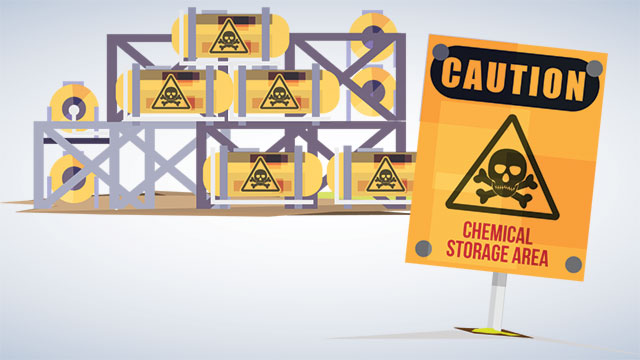Laboratory practices often imply exposure to hazardous fumes, particulate, and other gases. Chemicals fume hoods are the first defense to reduce or eliminate chemical exposure to research workers. They are enclosed, ventilated workspace, designed to prevent users and the environment from hazardous or toxic fumes, vapors and dust. They do not protect against every hazard! For that reason, it is an important thing to know what chemicals should be used in the enclosure.
What chemical should be used in a fume hood:
• Toxic gases like carbon monoxide, chlorine, nitrogen dioxide and phosgene
• Chemicals with strong odors (hazardous and non-hazardous ). Some of them may cause eye, nose, throat or lung irritation both
• Hazard Materials rated by NFPA with 3rd and 4th-degree health risks. These are chemical substances that can affect health or cause serious injury, during periods of short or very short exposure, even though prompt medical treatment is given.
• Volatile materials which are toxic like chloroform, formaldehyde.
• Flammable Materials
• Airborne concentrations: carcinogens, mutagens, teratogens, and other toxics
• A procedure that may create an aerosol of a toxic substance
• Explosive or reactive materials or chemicals that may spatter
Common laboratory hazardous substances
Examples of common laboratory hazardous substances can include acidic flammable liquids, organic acids, inorganic bases, oxidizing acids, oxidizers and even flammable liquids such as:
• Pyridine
• Hexane
• Acetonitrile
• Dimethylformamide
• Benzene
• Ethyl
• Tetrahydrofuran
• Ethyl Acetate
• Toluene
• Xylene
• Acetone
• Ethanol
• Methanol
Fume Hood Limitation

Fume hoods are effective devices used for containing hazardous substances and protecting lab workers from minor over-pressurizations and splashes. However, these enclosers have limitations and will require to follow safe work practices with the right precautions.
• Perchloric Acid – When the work requires Perchloric Acid, the vapors can create explosive perchlorate crystals within the ductwork of the traditional fume hood. These crystals are highly shock-sensitive and unstable, which can cause serious injury to the operator by detonating it on the surface. This type of work requires to use special type hoods – perchloric acid fume hoods. Made from glass, plastic, or stainless steel with a wash-down system, they prevent the formation of perchlorate salts.
• Biohazard materials – Laboratory fume hoods are made to work with chemicals materials but not for biomedical waste. The reason is that they would protect the user by pulling the air away and vent it outside but are not designed to protect the environment. Work that involves harmful microorganisms needs to be performed within biosafety cabinets instead of hoods.
• Highly toxic materials – When you work with highly dangerous substances, you will need more than what a fume hood can offer. In this case, use a glove box, which will isolate the worker from all direct physical contact with the toxin. Maintain the enclosure at negative air for better protection. If it does not offer adequate protection, use a glove box operating under negative pressure.
• Waste disposal – dispose of hazardous waste by evaporation in a fume hood violates the regulations of the environment and is not allowed by EPA without a permit. It constitutes illegal. Keep in mind that your fume hood is not a control device for pollution.
Copyright ©2020 Laboratory-Report.com. All Rights Reserved
• Pollution Control– Do not use unfiltered fume hoods as pollution control devices. The ventilation system removes every contaminant directly released into the atmosphere. In hoods, the apparatus used need to be fitted with scrubbers, traps, or condensers to collect and contain dust, toxic vapors, and waste solvents.
• Explosions– Traditional hoods are fire and chemical resistant but not constructed for containing explosions. Performing work with explosive materials, using blast shield, behind the hood sash is a must. The concentration should not exceed 25% of the Lower Explosive Limit when working with flammable chemicals. A common misconception is that the Explosion Proof hoods are capable of containing an explosion. They are equipped with specially designed electrical components that remove the potential of creating a spark suspected to prevent an explosion hazard, regardless of the kind of experiment inside the fume hood.
• Pressurized System – escaping vapors and gas fro pressurized systems may not be contained sufficiently within the fume hood.
• Particulate – fume hoods can’t contain high release velocities of particulate contaminants except with a fully-closed sash.
Listing of toxic and reactive highly hazardous chemicals by OSHA
Draft model training program for training employees who are exposed to hazardous chemicals, as required by OSHA
Can fume hoods be used to store chemicals?

During laboratory safety audits, our team often finds chemicals stored in the fume hood. Keeping it in is strongly discouraged for a few reasons:
• Performance of the fume hood – everything extra that is not used while work disturbs the airflow
• Open containers are considered as a treatment of hazardous waste by EPA.
• Flammable or reactive chemicals could cause an explosion or fire in the hood.
• Sorting incompatible chemicals could set up possibly hazardous reactions, which could result in an explosion or a fire.
OSHA also recommends storing materials in hoods to keep to a minimum and do not allow them to block vents or airflow. Also, do not permanently keep any chemicals inside the hood.
Chemicals should be stored in cabinets, manufactured to provide for safe containment of hazardous substances. Under fume hood storage cabinets is the best choice for a safe working environment in the laboratory.
There are available Flammable and ACID safety storage cabinets. To meet fire codes and safety regulations, store flammable liquids, corrosives, pesticides, and other dangerous materials, in fire-resistant safety cabinets.
Solid polyethylene ACID storage cabinets have a chemical resistance to handle the most corrosive chemicals. They safely store phenol, nitric acid and sulfuric acid.
Flammable Storage Cabinets safely store flammable fuels, solvents, and chemicals. The NFPA and OSHA require these types of cabinets to be able to limit the internal temperature to not more than 325°F in a 10-minute fire test. Flammable Storage usually comes with capped bung openings that allow for ventilation. In most cases, they do not need to be vented, but some local jurisdictions require it.
Standard storage cabinets – can be used to store and vent small laboratory instruments and mild acid and other reagents.
There are several types of specially designed Fume hoods for working with certain chemicals.
• Perchloric Acid Fume Hood – How we mentioned above dried perchloric acid is also highly explosive. These types of fume hoods require built-in water wash down systems to prevent dangerous reactions.
• Radioisotope Fume Hood – These are enclosures, designed to provide protection when the work requires radioactive materials.
They are constructed with a coved stainless steel liner and coved integral stainless steel worktops to withstand the weight of lead shielding plates.
• Acid Digestion Fume Hood – These hoods, usually made of polyvinyl chloride (PVC), are created to handle very concentrated acids at high temperatures. The hood’s sash window is made of polycarbonate to prevent the threat of glass etching caused by Hydrofluoric Acid.
• Downflow Fume Hood – Downflow Fume Hoods limit the exposure to hazardous or toxic fumes, vapors or dust, generated on the work surface. They are typically ductless hoods designed to protect the user and the environment.
Fume Hood liner materials
When choosing Fume Hood for your application to interior liner material must be compatible with the chemicals they are exposed to.
• Phenolic resin – used for general applications
• Fiber-reinforced plastic (FRP) – corrosion-resistant, durable, fire-resistant and light reflective. Not compatible with perchloric acid, and should not be used for acid digestions with highly corrosive acids at elevated temperatures
• Epoxy resin – used in non-corrosive or moderately corrosive environments. Good for heat resistance.
• Polypropylene – Polypropylene Fume hoods have great performance and durability with excellent chemical resistance.
• Stainless Steel Square Corners – This type of fume hoods have good chemical resistance to a wide range of reagents. They are ideal for use radiopharmaceutical, radiochemistry and nuclear pharmacy applications.
• Coved-corner stainless steel – They are built to provide maximum safety when working with radiopharmaceuticals and other radioactive materials.
